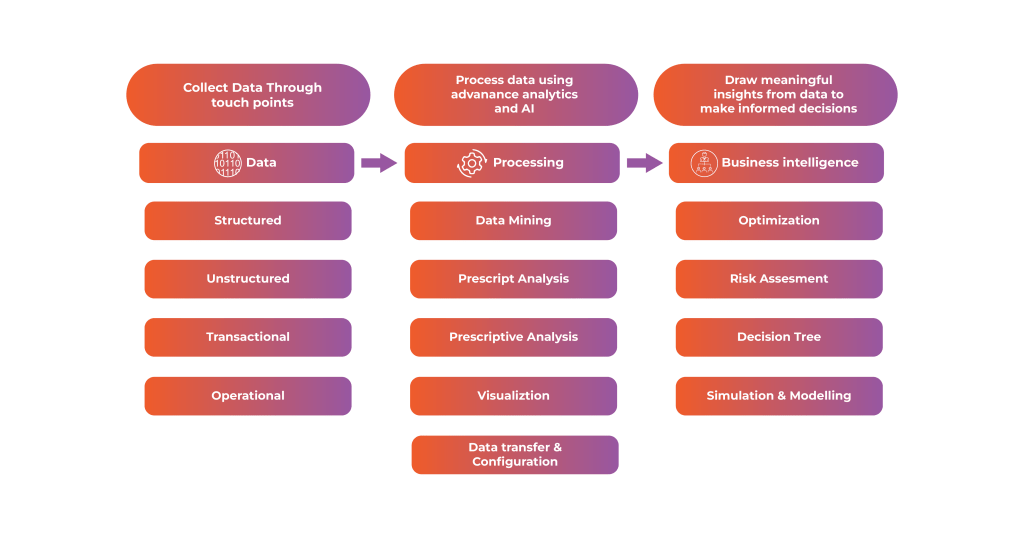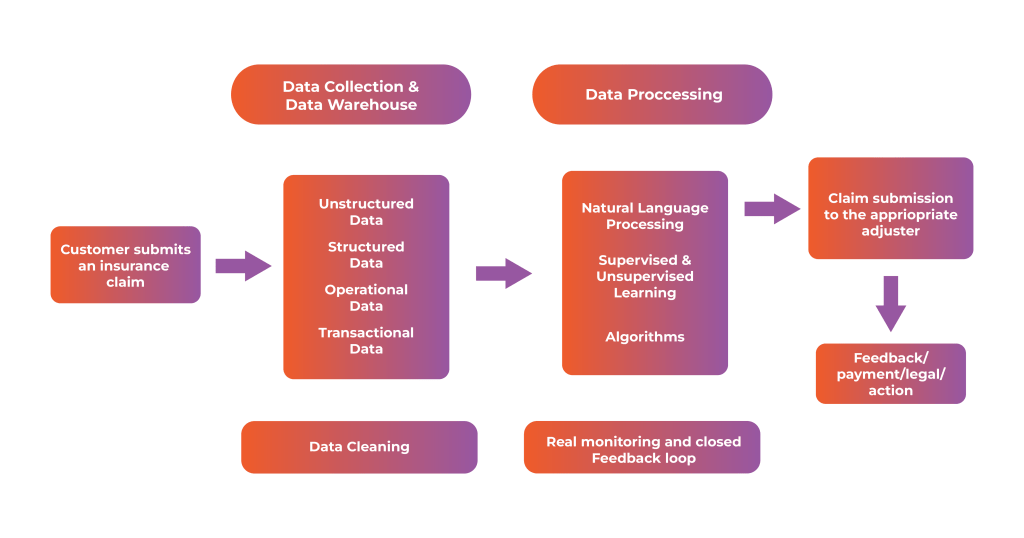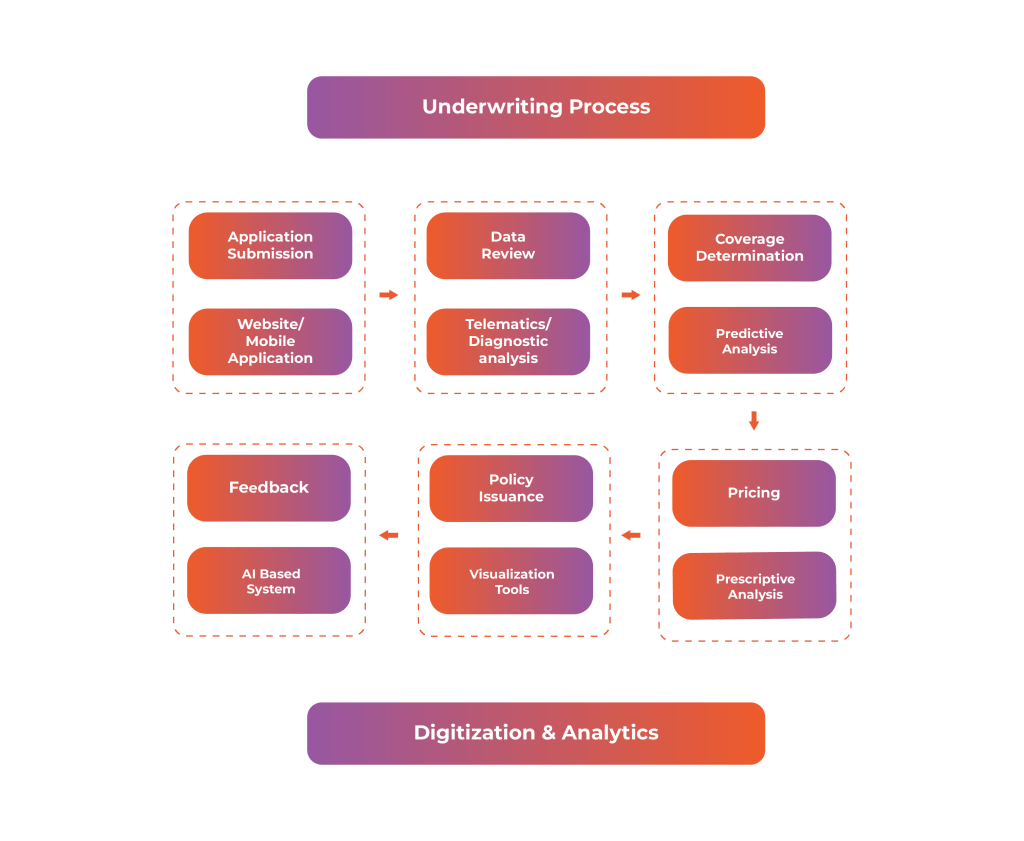HARNESSING THE POWER OF ADVANCED ANALYTICS
HARNESSING THE POWER OF ADVANCED ANALYTICS
HARNESSING THE POWER OF ADVANCED ANALYTICS
HARNESSING THE POWER OF ADVANCED ANALYTICS: UNLOCKING CUSTOMER NEEDS AND PREFERENCES FOR INSURANCE COMPANIES
The funding in the Insurtech sector increased from $4.9 billion USD in 2018 to a whopping
$16.7 billion USD in 2021 worldwide. The stagnant insurance industry is now changing;
increased customer demands, disruptive technology, fast adaption rates, the advent of
artificial intelligence, the significance of customer experience, availability of data, machine
learning, and optimized data analytics techniques have collectively transformed the
insurance business environment.
This era of disruptive technological advancement has increased customer power
significantly. Customer satisfaction is the goal of any service provider. The insurance industry
has also realized the immense potential of customer power and is working relentlessly to
improve user journeys. The insurance industry is driving from reactive techniques to
preventive measures. The sophisticated advanced analytics (AA) tools and techniques help
minimize fraudulent activities, personalize plans and charge premiums, and provide realistic
underwriting through machine learning. AA is a complete package tool that helps measure,
predict, and optimize organizational performance. Ranjit Bose, the Regents’
Professor of Management Information Systems at the Anderson School of Management of
the University of New Mexico, has put forward a three-fold foundational infrastructure
proposal for implementing AA (Artificial Intelligence and Analytics) within any organization.

Foundational Infrastructure Proposal for AA Implementation in Insurance Industry
These AA tools should be integrated across the functional units of the insurance organization to
deliver results. Insurance companies have access to various data points. However, the true
value lies in using these data points to make effective decisions. Turning data into useful key
insights is only possible by AA. Researchers have identified the following use cases of the
implementation of big data in the insurance sector that improves customer satisfaction.
USE CASES OF ADVANCED ANALYTICS TO ENHANCE CUSTOMER SATISFACTION
CUSTOMER SEGMENTATION AND PERSONALIZATION
Customers of today have ephemeral brand loyalties. They are constantly on the lookout for new
experiences and better products. Digitization has facilitated effortless accessibility and reduced
switching costs for the customer. Previously, customers primarily compared insurance plans
based solely on price, opting for the lowest option. However, the current trend indicates that
customers now prioritize enhanced consumer journeys and better experiences. As a result,
insurance companies have been compelled to transition from a product-centric mindset to a
customer-centric approach. The art of understanding the needs of various customer segments
and predicting their buying behavior lies in effective segmentation.
Advanced analytics unlocks limitless segmentation potential by handling 1000s of data sets
simultaneously. Traditionally, limited data sets, time consumption, human constraints, and
biases restrict segmentation. Machine learning algorithms and advanced visualization
techniques process real-time data instantly and provide a picturesque representation of data
which makes decision-making effective and efficient.
Segmentation identifies the right product for the right customer segment. Clustering techniques
are widely used to classify customers. Some segmentation frameworks are coined below to
understand the role of AA for customer satisfaction.
CUSTOMER SEGMENTATION FRAMEWORK USING RECENCY, FREQUENCY, AND MONETARY (RFM) AND CUSTOMER'S LIFETIME VALUE (LTV) MODELS FOR BANKING MARKETING STRATEGIES
A structured framework has recently been developed to apply Recency, Frequency, and
Monetary (RFM) customer’s lifetime value (LTV) models. This framework utilizes customers’
demographic data to segment banking customers and create effective marketing strategies. The
analysis study comprises two main phases: in the first phase, CRM data is employed to cluster
the customers, and in the second phase, demographic data variables such as age, education,
and occupation, selected through the SOM technique, are used to re-cluster the segments
obtained from the first step. Both of these steps employ the K-Means clustering technique. To
optimize the customer’s value, which is one of the study’s objectives, the comparison of
customer value uses LTV instead of inter/intra cluster distances
Another researcher developed a comprehensive framework to segment customers, compute
LTV for each segment, and project their future value. Employing K-means and two-step
clustering algorithms, two levels of clustering were applied to a substantial dataset of customer
transactions, encompassing deposit type, transaction date, balance before transaction, and
transaction amount. The customer’s lifetime value was determined using the RFM model,
renowned for its simplicity and effectiveness as a customer LTV approximation model.
Additionally, the study utilized a time series method, the multiplicative seasonal ARIMA
regression, to forecast future values for each segment
Another researcher developed a comprehensive framework to segment customers, compute
LTV for each segment, and project their future value. Employing K-means and two-step
clustering algorithms, two levels of clustering were applied to a substantial dataset of customer
transactions, encompassing deposit type, transaction date, balance before transaction, and
transaction amount. The customer’s lifetime value was determined using the RFM model,
renowned for its simplicity and effectiveness as a customer LTV approximation model.
Additionally, the study utilized a time series method, the multiplicative seasonal ARIMA
regression, to forecast future values for each segment
CUSTOMER ATTRITION AND RETENTION
A lost customer is an opportunity lost. Customer acquisition costs (CACs) are much greater
than customer retention costs. It is essential to look for factors that make customers lose trust in
the brand. Advanced analytics predict trends and map pain points in customers’ journeys to
determine reasons for leaving. It is estimated that 43.6% of customers leave due to poor
service quality. An AI service bot can handle claims and assist immediately. Predictive analysis
determines the customers’ lifetime value (CLV). This determines the profitability period of a
customer. It also gives insights on when to promote or demote a certain offer. Lemonade
Insurance uses AI technology to provide personalized plans to their customers and hence a
lower churn rate than industry giants. Proceedings of the 2011 International Conference on
Industrial Engineering and Operations Management held in Malaysia highlight an interesting
use case of customer retention using advanced analytics.
UTILIZING CUSTOMER BEHAVIOR ANALYSIS FOR BANK CUSTOMER SEGMENTATION AND RETENTION STRATEGIES
A comprehensive analysis study was conducted to segment bank customers based on their
behaviors, aiding the bank in devising retention strategies and attracting new customers. The
dataset used for analysis integrates three tables: customers’ demographic data, transaction
records, and bank card data. The study considers essential information and combines attributes
such as transaction type, transaction frequency, service type, bank type, and channel type
(ATM, Web, and Terminal) with other customer attributes. The author employed Artificial Neural
Networks (ANN) to classify the factors based on their profitability.
T. L. Oshini Goonetilleke identifies the use of decision trees and neural networks to reduce
churn rate in his works titled as Mining Life Insurance Data for Customer Attrition Analysis
ANALYZING CUSTOMER DATA IN LIFE INSURANCE COMPANY CRM TO PREVENT CHURN
This research focused on life insurance company CRM data aimed to analyze customer data
and mitigate churn and attrition. The data is extracted from an operational database: the dataset
covers life insurance policies with an average term of 18-20 years, necessitating the mining of a
significant amount of historical data to build an efficient model. The study incorporated
demographic data (gender, age, profession, etc.) as well as policy details like term, sum
assured, premium, and agent information. Visualizations, Correlation-based Feature Selection
(CFS), and Information Gain techniques were utilized to select relevant attributes or attribute
combinations. The classifiers employed included the J48 decision tree and Artificial neural
network model with a standard Multilayer Perceptron. Additionally, the study addressed
challenges related to the dataset’s numerous attributes and the need for human intervention in
various stages of analysis
CUSTOMER ONBOARDING AND ENGAGEMENT
In today’s digital age, customers expect simple language, easy procedures, hands-on
applications, and immediate processing. No one wants to wait for days for a query to be
answered or a lengthy mail document filled with industry jargon to sign for a policy change to
implement. Insurance companies need to invest in easygoing yet state-of-the-art applications
and faster processing. Digital Onboarding is the need for today. It is easy on the pocket and
heavy on the heart. To drive engagement, insurance companies use channels such as video
marketing, email marketing, and interactive marketing. For example, a personalized email
message on a birthday can result in a lifetime customer a insurance policy.
CLAIMS MANAGEMENT
Claims Management is an integral part of insurance processes. An insurance company is
responsible for managing thousands of claims every day. This is a hefty job that requires
in-depth analysis and expertise. IoT and Data management capabilities have made this easy.
Claims management software can process these claims and characterize them based on
urgency, revenue, fraud, expertise, and legal assistance required. Advanced analytics and AI
collectively can handle day-to-day claims efficiently. This saves money, resources, and time.
Claims subrogation management can be optimized using the power of analytics. Complex
mathematical models predict recovery trends, claims processing costs, and recovery potential
based on historical patterns of liability trends, litigation data, and mitigation efforts.
Simultaneously predictive and prescriptive analysis process claims information and assigns the
best-suited adjuster for the job. This reduces inefficiencies in the system and increases
customer satisfaction.

Framework for claims management using Advance Analytics
TELEMATICS AND USAGE BASED INSURANCE
Usage-based insurance has transformed the insurance industry’s outlook. Telematics is widely
used in auto insurance where a black box is installed in the car which monitors driving habits.
Additionally, data is gathered through police records, previous claims, vehicle maintenance, and
challans issued. This helps insurance companies in determining the high-value vs high-risk
customers. It also favors customers as they pay for what they are worth.
Soon telematics will begin to penetrate the home and life insurance. A customer that agrees to
potential data tracking of health records via applications or smart trackers can save an amount
on insurance. Similarly, a well-maintained house that has water sprinklers, an automated water
shut-off device, and house security control installed will have a lower insurance fee and lower
risk than a worn-out house.
RISK ASSESSMENT AND UNDERWRITING
Risk assessment is a lucrative task, if done wrong, it would cost millions. However, a human
has limitations and can only process limited data. Advanced analytics and machine learning
have made it easy to quantify and qualify hundreds of data points at once. Multiple risk
parameters can be processed with claims data, to identify potential risk types and impacts. The
predictive models help in identifying optimized risk scoring and expense ratio to write the
correct underwriting policy. Analytics speeds up the entire underwriting process. Analytics
influence all steps of underwriting. From initial data review to final policy issuance, the use of
AA optimizes the process.

The insurance industry is growing at a CAGR of 12% and is expected to reach a market value
of $9.8 trillion (about $30,000 per person in the US) by 2027 globally. The insurance market is
submerged with new startups, out of which 53% are from the United States alone. This
exponential growth in the insurance industry makes it challenging for companies to keep their
competitive edge. Multiple options in the market and low switching costs have made customer
retention and acquisition difficult. It is important to penetrate user minds and map their journeys
to provide a better experience. The penetration of IoT & cloud computing technology has
rewired consumers to look out for a one-stop solution. Nowadays customers don’t want a car
insurance plan or a health insurance plan but a package deal. A car insurance plan that
includes car maintenance and rewards for safe driving is much more appealing than a
traditional car insurance plan. The insurance core products are losing their touch and
non-insurance products such as financial planning or home maintenance plans are in demand.
The future of the insurance industry is by preventive measures rather than reactive rewards.
Customers require instant access to information and assistance digitally via mobile applications
or websites. The use of an AI virtual bot to handle customer queries and claims will increase
customer satisfaction and reduce costs
The future of the insurance industry belongs to the insurance companies that proactively
integrate these technological advancements into their integrated systems, establish relevant
partnerships, invest in employee skills, and implement effective change management across the
entire company to leverage the full potential of these technologies. A leading insurance industry
OP Financial installed a virtual chatbot that converses in the native language to its customers
and reduces customer waiting time to zero. Together with Indian Farmers Fertiliser Cooperative
Limited (IFFCO) and the Tokio Marine Group, IFFCO Tokio General Insurance Company Limited
innovated claims handling by integrating an AI-based Claim Damage Assessment Tool that uses
computer images and neural networks to identify vehicle damages.This reduces claim
management costs by 30% and optimizes time from four hours to just fifteen minutes.
Corebridge Financials have recently partnered with Blackstone and Blackrock (Innovative
investment management solutions companies) to strengthen their business model.
These collaborations form the foundation of their innovative investment model, combining their
expertise in asset allocation determination, asset and liability management profiling, and risk
management with the expertise of world-class asset managers. Furthermore, by integrating
BlackRock’s Aladdin platform, they are revolutionizing their investment platform with expanded
analytics and accounting capabilities.The climate in the insurance industry is transforming as
more companies look for innovative solutions. In this era of disruption, innovation leads to
profitability. Big Data is a game changer for the Insurance industry. The future belongs to early
adopters and innovators. It’s either innovate today or regret later.
